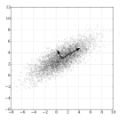Building performance is commonly calculated during the last phases of design, where most design specifications get fixed and are unlikely to be majorly modified based on design programs. Predictive models could play a significant role in informing architects and designers of the impact of their design decisions on energy consumption in buildings during early design stages. A building outline is a significant predictor of the final energy consumption and is conceptually determined by architects in the early design phases. This paper evaluates the impact of a building's outline on energy consumption using synthetic data to achieve appropriate predictive models in estimating a building's energy consumption. Four office outlines are selected in this study, including square, T, U, and L shapes. Besides the shape parameter, other building features commonly used in literature (i.e., Window to Wall Ratio (WWR), external wall material properties, glazing U value, windows' shading depth, and building orientation) are utilized in generating data distribution with a probabilistic approach. The results show that buildings with square shapes, in general, are more energy-efficient compared to buildings with T, U, and L shapes of the same volume. Also, T, U, and L shape samples show very similar behavior in terms of energy consumption. Principal Component Analysis (PCA) is applied to assess the variables' correlations on data distribution; the results show that wall material specifications explain about 40% of data variation. Finally, we applied polynomial regression models with different degrees of complexity to predict the synthesized building models' energy consumptions based on their outlines. The results show that degree 2 polynomial models, fitting the data over 98% R squared (coefficient of determination), could be used to predict new samples with high accuracy.
翻译:建筑性能通常在设计的最后阶段计算,在设计的最后阶段,大多数设计规格得到固定,不太可能根据设计程序进行重大修改。预测模型可以在向建筑师和设计师通报其在设计初期设计阶段对建筑物能源消耗所作设计决定的影响方面发挥重要作用。建筑大纲是最终能源消耗的重要预测,在概念上由设计师在早期设计阶段确定。本文评估建筑对能源消耗的影响,利用合成数据,在估算建筑物的能源消耗方面实现适当的预测性模型。在本研究中选择了四个办公大纲,包括平方、T、U和L等形状。除了形状参数参数外,在文献中通常使用的其他建筑特征(即Work to Wall Riight (WWWorldRRR),外部壁材料特性属性属性属性,由建筑设计师在早期设计阶段中确定。本文评估建筑物对能源消耗水平的预测性能效率,一般而言,平方形建筑物的能量效率高于与T、U和L等结构的精确度。此外,在模型中,使用铀结构的温度分析结果显示,最终显示铀结构的能量结构, 显示其结构的能量结构,其结构的数值分析结果显示,其最终的能量结构显示,其结构的能量结构显示,其结构结构显示,其结构的温度值值值值为: 数据显示,其结构结构结构的温度值值为:



